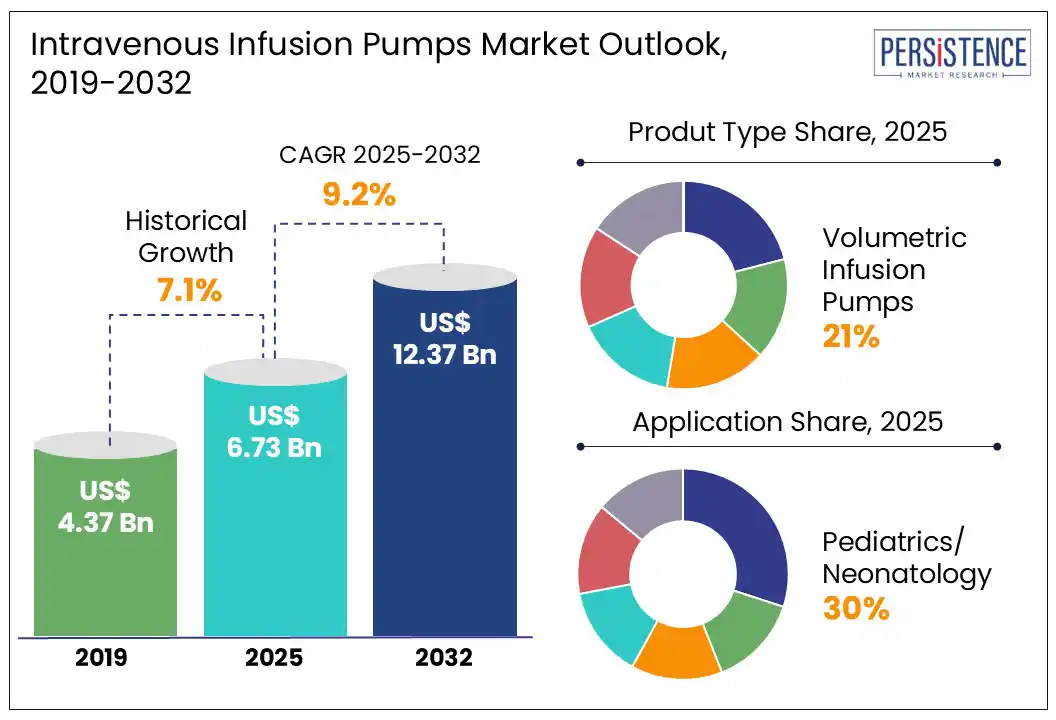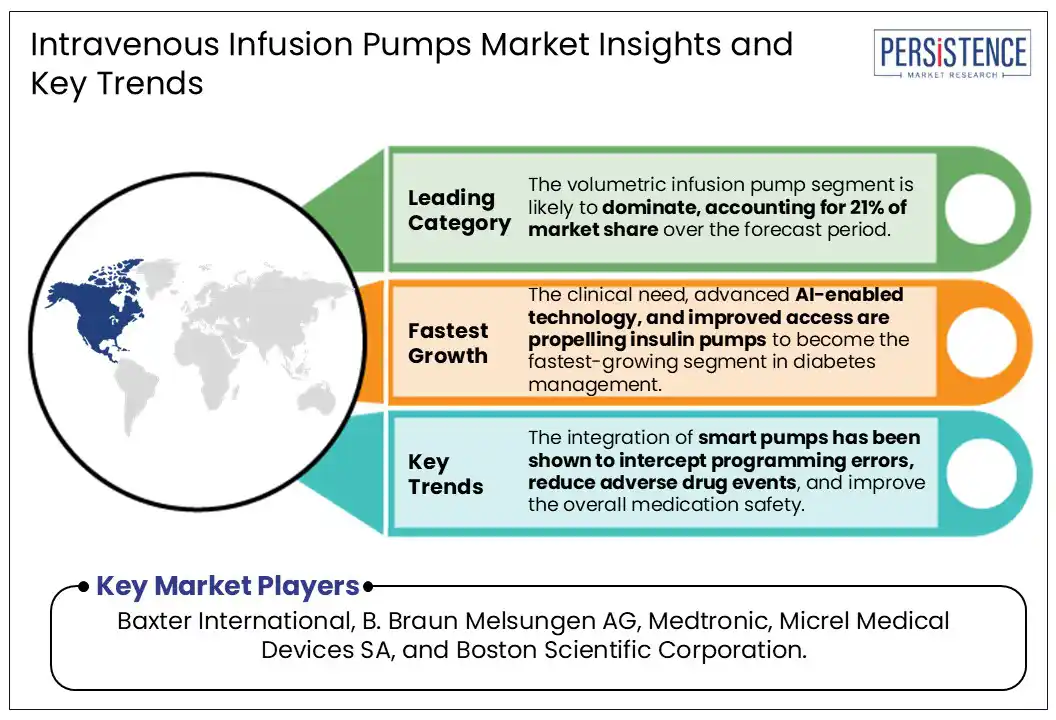ID: PMRREP33220| 186 Pages | 18 Jul 2025 | Format: PDF, Excel, PPT* | Healthcare

Global Intravenous Infusion Pumps Market size is likely to be valued at US$ 6.73 Bn in 2025 and is estimated to reach US$ 12.37 Bn in 2032, at a CAGR of 9.2% during the forecast period 2025 - 2032.
The intravenous infusion pumps market growth is driven by the rising prevalence of chronic diseases, increasing geriatric population, growing incidence of surgical procedures and hospital admissions, growth in home-based therapy, and rapid technological innovations in smart, connected pumps.
An intravenous infusion pump is a medical device used by medical professionals to administer fluids, such as insulin or other hormones, antibiotics, chemotherapy drugs, and pain relievers, into a patient’s body in a controlled manner. These pumps come in various types, including volumetric, insulin, syringe, ambulatory, and Patient-Controlled Analgesia (PCA). Latest advancements include smart infusion pumps that feature integrated drug libraries, dose-error reduction systems (DERS), IoT connectivity with EHRs, real-time monitoring, alarms, and AI-enabled functionalities, which significantly reduce medication errors and enhance safety.

Key Industry Highlights
|
Global Market Attribute |
Key Insights |
|
Intravenous Infusion Pumps Market Size (2025E) |
US$ 6.73 Bn |
|
Market Value Forecast (2032F) |
US$ 12.37 Bn |
|
Projected Growth (CAGR 2025 to 2032) |
9.2% |
|
Historical Market Growth (CAGR 2019 to 2024) |
7.1% |
According to the December 2024 WHO report, noncommunicable diseases (NCDs) included heart disease, stroke, cancer, chronic respiratory diseases, and diabetes. In 2021, NCDs claimed at least 43 million lives, accounting for 75% of non-pandemic-related global deaths. Infusion pumps are crucial critical-care devices, used widely in ICUs, CCUs, emergency departments, and COVID wards. Handling the NCD crisis involves detection, screening, treatment, and palliative care. As the incidence of these chronic diseases continues to increase due to tobacco use, physical inactivity, alcohol consumption, unhealthy diets, and air pollution, there is a higher demand for intravenous infusion pumps.
The latest U.S. median age reached a record 39.1 years in 2024, marking a steady aging trend. According to the CDC's Behavioral Risk Factor Surveillance System for 2023, 51.4% of U.S. adults reported having two or more chronic health conditions. This increasing disease burden often leads to complex medication schedules, increasing the risk of medication errors. In clinical settings where intravenous therapy is required, smart infusion pumps can play a vital role in minimizing such errors through controlled and accurate drug delivery.
Infusion pumps are critical for administering life-saving fluids and high-risk medications. Mechanical and software defects, such as damaged housings, worn rollers, motor failures, and electrical faults, can endanger patient safety, leading to overdoses or treatment delays. From 2005 to 2009, the FDA logged over 56,000 adverse events, including over 500 deaths, and issued 87 recalls (70 Class II, 14 Class I), highlighting continuing issues across all pump types, and emphasizing strict compliance with 21 CFR 880.5725 and IEC 60601 1 Type B design standards.
In May 2025, Zyno Medical issued a Class I recall for certain Z 800 series pumps due to uncertified software, which compromised air-in-line detection, alarm volume, and reverse-flow prevention that may cause serious issues such as air emboli, drug misdelivery, and catheter occlusion. In June 2025, the FDA issued a Class I recall of Smiths Medical CADD Solis and VIP ambulatory pumps due to false upstream occlusion alarms, potential thermal battery/wireless module damage, and intermittent wireless connectivity.
Smart infusion pumps are next-generation intravenous devices that combine programmable drug libraries, safety software (DERS with hard/soft limits), and interoperability features, such as barcode scanning and bidirectional EHR connectivity, to enhance medication safety and workflow efficiency. These pumps set predefined limits for medication administration, preventing incorrect dosing or infusion rates. The integration of smart pumps will mitigate programming errors, reduce adverse drug events, and enhance medication safety. Modern smart infusion pumps are equipped with wireless connectivity and barcode medication administration (BCMA) capabilities, thereby ensuring accurate and timely medication delivery.
Integration with EHR systems allows real-time data synchronization and reduction of manual entry errors, thereby supporting seamless communication between devices and healthcare platforms. AI-enhanced intravenous infusion pumps are revolutionizing the drug delivery by combining real-time patient monitoring, predictive analytics, and seamless connectivity. Machine learning algorithms embedded in devices such as Baxter’s Novum IQ detect abnormalities in infusion rates to prevent overdosing, auto-adjust dosing based on physiological data, and flag maintenance needs before failures occur.
By product type, the volumetric infusion pump segment is likely to dominate, accounting for 21% of market share in 2025. These pumps are motor-driven and deliver medications, nutrients, or blood into a patient’s bloodstream at controlled rates. Safety is improved through built-in alarms for occlusion, air-in-line, low or high pressures, low battery, and end-of-infusion. Volumetric pumps are used widely in hospitals, ICUs, surgical suites, and home-care settings due to their rechargeable batteries and lightweight designs.
Next-generation volumetric infusion pump models feature AI-driven precision, using machine learning to detect infusion anomalies, predict maintenance needs, and optimize drug delivery in real time. The leading manufacturers include B. Braun Melsungen AG, Becton, Dickinson & Company (BD), and Fresenius Kabi AG.
The insulin infusion pump segment is likely to grow at the fastest rate over the forecast period. According to International Diabetes Federation, in 2024, approximately 589 million adults (20-79 years) lived with diabetes. The total number of people living with diabetes is projected to rise to 853 million by 2050, driving the demand for insulin pumps. An insulin pump is a small, wearable, and computerized medical device that continuously delivers rapid-acting insulin through a cannula placed just under the skin, providing insulin including mealtime or correction boluses, administered either manually or automatically.
Insulin pumps are available as tubed or tubeless (patch) models, and they offer precision dosing down to fractions of a unit, customizable basal rates, bolus calculators, and safety alarms for low reservoir, occlusion, or hypoglycemia. Bluetooth/smartphone interfaces, predictive bolus calculators, and compact, tubeless designs, boost patient adherence. Medtronic, Insulet, and Tandem Diabetes Care are the key manufacturers.
By application, the pediatrics/neonatology segment is likely to dominate, accounting for approximately 30% of the market share over the forecast period. Advances in pediatric medicine and rising birth rates create a strong need for Neonatal Intensive Care Units (NICUs) and pediatric wards. Neonates and children often require highly accurate fluid and medication administration, where high volumetric accuracy is essential.
Pediatric-specific pump innovations, such as micro-infusion features, programmable low flow rates, and child-safe interfaces, boost adoption in both hospital and homecare settings. North America and APAC (China and India) are key growth zones, supported by rising neonatal intensive care capacity. Hospitals and governments continue to invest heavily in NICU and Pediatric Intensive Care Unit (PICU) infrastructure, supported by regulations such as the EU’s Pediatric Regulation.
The chemotherapy segment is anticipated to witness significant growth. The global cancer burden is projected to increase significantly, with over 35 million new cases expected by 2050, necessitating reliable and precise drug delivery systems to ensure effective treatment outcomes.
Innovations such as smart pumps with DERS, real-time monitoring capabilities, and integration with electronic medical records enhance the safety and efficacy of chemotherapy administration. The growing trend of outpatient and home-based chemotherapy treatments drives the demand for portable and user-friendly infusion pumps. Mindray has incorporated an innovative infusion mode called Rhythm DoseTM in its latest BeneFusion i/u series. This feature enables healthcare professionals to administer continuous intravenous infusions of multiple drugs used in chemotherapy at varying rates.

North America is estimated to hold a share of 54% in 2025, driven by its high chronic disease burden (over 2 million new cancer cases annually, 6.7 million Americans with heart failure, and 34 million diabetic patients), rising surgical volumes, and an aging population. The region’s tech leadership and innovation including FDA-cleared AI-enhanced systems (BD Alaris Guardrails MX, Baxter’s Dose IQ, Moog’s CURLIN 8000), and Canada’s April 2024 launch of BD Alaris EMR interoperability at Mackenzie Health have accelerated the adoption of smart, connected pumps.
The U.S. is experiencing significant growth. Key trends include rapid adoption of smart, connected devices featuring AI-enabled dosing, DERS, Wi-Fi/Bluetooth integration, and bi-directional EHR connectivity. The market remains highly fragmented, with major players consolidating through M&A such as Fresenius Kabi’s acquisition of Ivenix and ICU Medical obtaining FDA clearance for its Plum Duo, its dual-channel precision infusion pump. Home and ambulatory infusion is expanding, transitioning toward outpatient and telehealth models.
Asia Pacific is likely to be the fastest growing over the forecast period. A large and aging population, rising chronic disease burdens, particularly in diabetes, cancer, and cardiovascular conditions, and increasing surgical and ICU demand are fueling the need for infusion therapy across hospitals and home-care settings. Increased investment in hospitals, outpatient clinics, and home-infusion services (supported by government programs including India’s PM-JAY) is boosting the adoption of infusion pumps. China, Japan, and India are also exhibiting high growth, reflecting strong demand for advanced systems.
China is anticipated to experience rapid growth over the forecast period, driven by a large and aging population, a high burden of chronic diseases, and increasing surgical procedures. There is a significant demand for home care solutions, prompting a shift toward ambulatory and home-based infusion therapies. Domestic manufacturers such as Mindray Medical and Sino Medical are enhancing their infusion pump offerings, contributing to market expansion.
Europe is experiencing steady growth, driven by an aging population, increasing chronic disease prevalence, and advancements in infusion technology. Germany leads the region, and the U.K. is anticipated to register the highest growth rate during the forecast period, reflecting a surge in the demand for insulin infusion pumps, particularly in home-care settings. Recent advancements include the development of smart infusion pumps equipped with AI and wireless connectivity. In April 2024, Baxter International Inc. received FDA 510(k) clearance for its Novum IQ large-volume infusion pump with Dose IQ Safety Software.
Germany is expected to witness rapid growth over the forecast period. The demand for infusion devices is rising due to the aging population & rising chronic diseases with 21% of the population over 65 and growing rates of cancer, diabetes, cardiovascular issues. Government incentives such as Germany's Hospital Future Act, and digitization efforts are boosting the adoption of connected and safety-enhanced smart pumps. The key players include B. Braun, Fresenius Kabi, Baxter, BD, ICU Medical, and Terumo.
The global intravenous infusion pumps market is shaped by key players including Baxter International, Medtronic, B. Braun Melsungen, and Fresenius Kabi. These companies focus on technological innovations, including the development of smart infusion pumps with DERS and drug libraries to enhance patient safety.
The global intravenous infusion pumps market is projected to be valued at US$ 6.73 Bn in 2025.
Market growth is driven by rising prevalence of chronic diseases, increasing geriatric population, growing incidence of surgical procedures and hospital admissions, growth in home-based therapy, and rapid technological innovations.
The intravenous infusion pumps market is poised to witness a CAGR of 9.2% from 2025 to 2032.
The integration of smart pumps has been shown to intercept programming errors, reduce adverse drug events, and improve overall medication safety.
Major players in the global Intravenous Infusion Pumps Market include Baxter International, B. Braun Melsungen AG, Medtronic, Micrel Medical Devices SA, and Boston Scientific Corporation.
|
Report Attribute |
Details |
|
Historical Data/Actuals |
2019 - 2024 |
|
Forecast Period |
2025 - 2032 |
|
Market Analysis |
Value: US$ Bn |
|
Geographical Coverage |
|
|
Segmental Coverage |
|
|
Competitive Analysis |
|
|
Report Highlights |
|
|
Customization and Pricing |
Available upon request |
By Product Type
By Application
By End-user
By Region
Delivery Timelines
For more information on this report and its delivery timelines please get in touch with our sales team.
About Author